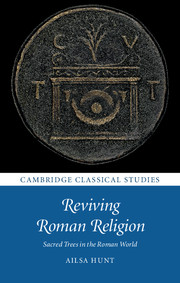Book contents
- Frontmatter
- Dedication
- Contents
- List of figures
- Acknowledgements
- 1 Rooting in: why give time to sacred trees?
- 2 A brief history of tree thinking: the enduring power of animism
- 3 How arboreal matter matters: rethinking sacrality through trees
- 4 Arboriculture and arboreal deaths: rethinking sacrality again
- 5 Confronting arboreal agency: reading the divine in arboreal behaviour
- 6 Imagining the gods: how trees flesh out the identity of the divine
- 7 Branching out: what sacred trees mean for Roman religion
- Appendix
- Bibliography
- Index
3 - How arboreal matter matters: rethinking sacrality through trees
Published online by Cambridge University Press: 05 September 2016
- Frontmatter
- Dedication
- Contents
- List of figures
- Acknowledgements
- 1 Rooting in: why give time to sacred trees?
- 2 A brief history of tree thinking: the enduring power of animism
- 3 How arboreal matter matters: rethinking sacrality through trees
- 4 Arboriculture and arboreal deaths: rethinking sacrality again
- 5 Confronting arboreal agency: reading the divine in arboreal behaviour
- 6 Imagining the gods: how trees flesh out the identity of the divine
- 7 Branching out: what sacred trees mean for Roman religion
- Appendix
- Bibliography
- Index
Summary
After his conversion to Christianity, Arnobius found time to reflect on the thinking behind his former pagan self's veneration of idols, stones and trees:
venerabar, o caecitas, nuper simulacra modo ex fornacibus prompta, in incudibus deos et ex malleis fabricatos, elephantorum ossa, picturas, veternosis in arboribus taenias; si quando conspexeram lubricatum lapidem et ex olivi unguine sordidatum, tamquam inesset vis praesens, adulabar, adfabar et beneficia poscebam nihil sentiente de trunco, et eos ipsos divos, quos esse mihi persuaseram, adficiebam contumeliis gravibus, cum eos esse credebam ligna lapides atque ossa aut in huiusmodi rerum habitare materia. (Ad. nat. 1.39.1)
In my blindness I used to worship statues recently brought out from the furnace, gods made on anvils with mallets, bones of elephants, paintings, ribbons on ancient trees; if ever I caught sight of a stone anointed and meanly dressed with olive oil, I used to adore it as if it had an internal force, I used to address and demand benefits from an insentient tree trunk, and I afflicted with serious insults those very gods, whom I had persuaded myself existed, since I used to believe them to be bits of wood, stones and bones, or to live in the matter of things of that kind.
Two factors were at play in his idiocy. The first was a deluded ‘animistic’ conception of such objects: he would worship an idol or stone or tree ‘as if it had an internal force’ (tamquam inesset vis praesens). Nineteenth-century lauding of ‘animism’ as the interpretative key to tree worship was, we see, no innovation. The second factor was a category mistake which resulted in Arnobius conceiving of gods either as synonymous with bits of wood, stones or bones, or as inhabitants of such objects. Sulpicius Severus also characterised pagan tree worship as a ridiculous category mistake. In his Life of St Martin, we read how the hero Martin had succeeded in destroying a pagan shrine, but once he moved to attack its associated tree found himself facing organised opposition.
- Type
- Chapter
- Information
- Reviving Roman ReligionSacred Trees in the Roman World, pp. 72 - 120Publisher: Cambridge University PressPrint publication year: 2016



